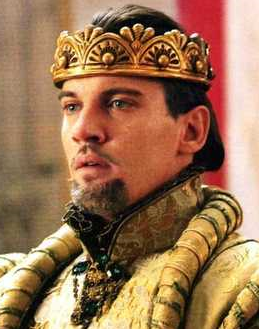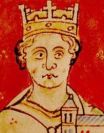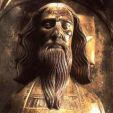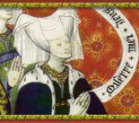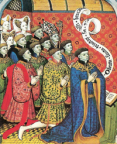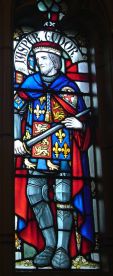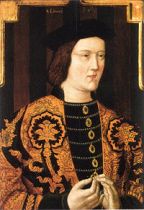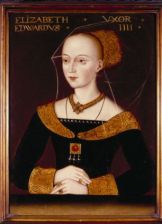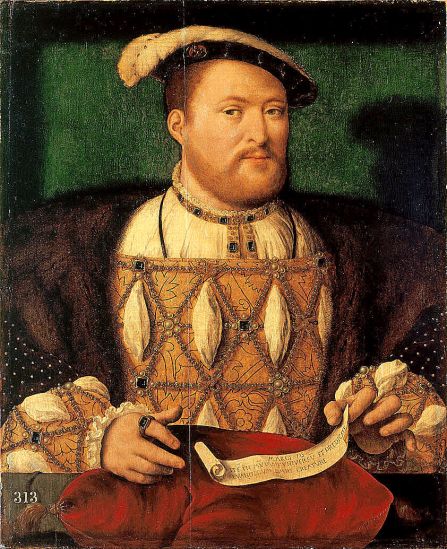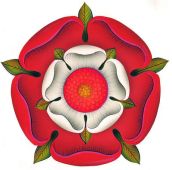King Henry VIII's Ancestors
[Contemporary images where they exist]
Click EasyEdit to add/edit this page (Don't see the EasyEdit button above? <a href="/#signin" target="_self">Sign in</a> or <a href="/accountnew" target="_self">Sign up</a>.) | 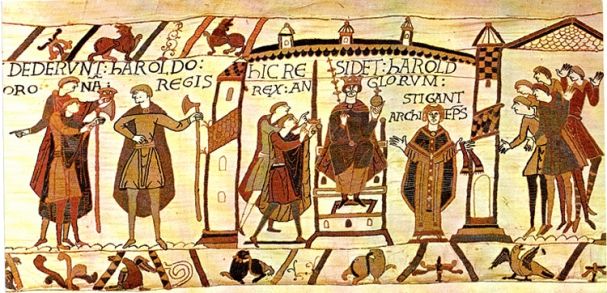 William the Conqueror William the Conqueror
King of England
AKA William I and William the Bastard
as he was the illegitimate son of Robert I, Duke of Normandy
c. 1027-1087 see also : <a class="external" href="http://www.youtube.com/watch?v=hvjaWL98gJE" rel="nofollow" target="_blank" title="David Starkey on William I of England">David Starkey on William I of England</a>
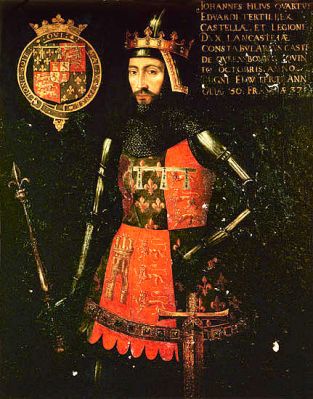 Royal, handsome, intelligent, athletic, powerful and wealthy, John of Gaunt (a Plantagenet) strode across the stage of 14th century England in a blaze of charisma. He was the 3rd son of an English King, Edward III, and the father of another, Henry IV. His legitimate daughters married into the royal families of Portugal and Spain, and were Queens and the mothers of Kings. John of Gaunt's power and wealth were greatly enhanced by two very advantageous marriages, but he made the most of all the opportunities which came his way.
As a young man, he married the heiress Blanche of Lancaster. Through her, he became Duke of Lancaster and the wealthiest man in England.Together they had three children, including Henry Bollingbroke, the future Henry IV.
After Blanche's death from the Plague, John of Gaunt married Constance of Castile, the usurped and exiled heir to the throne of Castile. He claimed the Crown of Castile by right of his wife.In his old age, John of Gaunt married for a third time. No Duchess or Queen this time, rather he married his long-t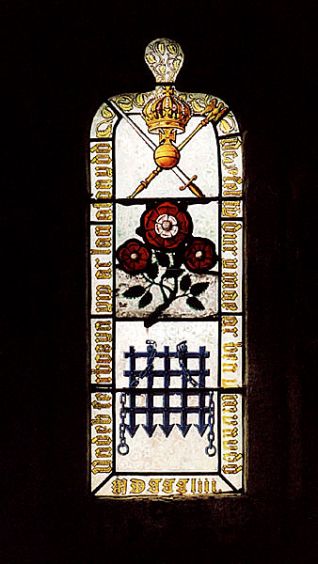 erm mistress. erm mistress.
Katherine Swynford was the daughter of an obscure, lowly knight, and the widow of another. She was also the mother of John of Gaunt's four bastard children, the Beauforts. The children were declared legitimate in 1390 (and Gaunt married their mother in January 1396), this was on the condition that they be barred from ascending the throne. Undeterred by this, upon the failure of the primary Lancastrian line, the Tudors claimed precedence to the Yorks and eventually succeeded them.
John of Gaunt and Katherine Swynford had four children during their affair: - John Beaufort, 1st Earl of Somerset, who married Margaret Holland *Henry VIII descended from this line;
- Henry, Cardinal Beaufort;
- Thomas Beaufort, Duke of Exeter, who married Margaret Neville
- Joan Beaufort, who married (1) Robert Ferrers, 3rd Baron Ferrers of Wemme and (2) Ralph Neville, 1st Earl of Westmoreland. * Henry VIII also descended from this line.
They were given the surname "Beaufort" after some of John of Gaunt's lost French lands (Beaufort in Champagne). As they were unlikely to be retrieved, this did not threaten the inheritance of John's legitimate children, particularly his heir, Henry of Bolingbroke (Henry IV). From this unlikely couple came the House of Tudor - Henry VII's mother was Margaret Beaufort. King Henry VIII's emblem was the Tudor rose and the Beaufort portcullis [see stained glass picture above] signifying his tenuous link to royal blood through Margaret Beaufort. |

John Beaufort
1st Earl of Somerset
c1373-1410
Father of John Beaufort | 
Lady Margaret Holland
Countess of Somerset
1385-1439
Mother of John Beaufort | 
Charles VI de Valois
King of
France
1368-1422
Father of Catherine of Valois | 
Isabeau of Bavaria
Queen of France
1371-1435
Mother of Catherine of Valois |
|
|
|
|
Lady Joan Beaufort
Only daughter of John of Gaunt
1379-1440
Mother of Cecily Neville | Sir Ralph Neville
1st Earl of Westermorland
1364-1425
Father of Cecily Neville | 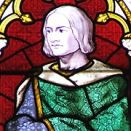 Richard Richard
of Conisburgh,
3rd Earl of Cambridge
c1376-1415
Father of Richard Plantagenet | 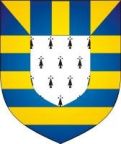
Lady Anne
de
Mortimer
1390-1411
Mother of Richard Plantagenet |

John Beaufort
1st Duke of Somerset
1404-1444
Father of
Margaret Beaufort | 
Lady Margaret Beauchamp of Bletsoe
c1410-1482
Mother of Margaret Beaufort
| 
Catherine of Valois
1401-1437
Mother of
Edmund Tudor
see below
| 
Owen Tudor
c1400-1461
(2nd husband)
Father of Edmund Tudor | 
Richard Plantagenet 3rd Duke of York
1411-1460
Lord Protector during Henry VI's madness, as well as father of the future kings Edward IV and Richard III
| 
Lady Cecily
Neville
1415-1495
Mother of Edward IV
and Richard III
| 
Richard Woodville 1st Earl Rivers
Father of Elizabeth Woodville | 
Jacquetta
of Luxembourg
Mother of Elizabeth Woodville |
Catherine of Valois' first husband, Henry V (right)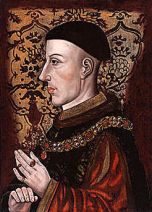 , died suddenly in 1422. Catherine was effectively exiled from court, suspicion falling on her nationality. She was passed over by her brothers-in-law as regent for her son Henry VI, and kept away from him. Catherine entered into a relationship with Owen Tudor, and later married him. Owen was a Welsh courtier, who would become the founding father of the Tudor dynasty. In 1436 Owen Tudor was imprisoned; Catherine retired to Bermondsey Abbey, where she died on the 3rd of January 1437. Owen was initially promised a safe return to Wales, but he was re-arrested and taken to Newgate. He escaped and went back to Wales. , died suddenly in 1422. Catherine was effectively exiled from court, suspicion falling on her nationality. She was passed over by her brothers-in-law as regent for her son Henry VI, and kept away from him. Catherine entered into a relationship with Owen Tudor, and later married him. Owen was a Welsh courtier, who would become the founding father of the Tudor dynasty. In 1436 Owen Tudor was imprisoned; Catherine retired to Bermondsey Abbey, where she died on the 3rd of January 1437. Owen was initially promised a safe return to Wales, but he was re-arrested and taken to Newgate. He escaped and went back to Wales.
When Henry VI was of age he made provisions for his stepfather Owen, who took up the red rose of Lancaster and fought for it bravely and well. Owen's last battle came at Mortimer's Cross on Febuary 4, 1460. He was captured by the Yorkists, who beheaded him in Hereford marketplace and set up his head on the market cross. Owen Tudor and Catherine de Valois had five surviving children.
Their two oldest sons were Edmund Tudor, 1st Earl of Richmond,
and Jasper Tudor, 1st Duke of Bedford & Earl of Pembroke (pic on right).
These two men were to play an important role in the
future of the English monarchy.
|
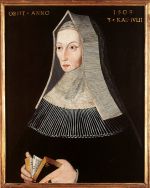
Lady Margaret Beaufort
born - 1443 - died 1509
*descended from John of Gaunt's illegitimate son
Mother of Henry VII |
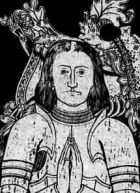
Edmund Tudor
Earl of Richmond,
born c.1430 - died 1456
Half-brother of Henry VI, Father of Henry VII | Edward IV of York
born 1442 – died 1483
Brother of Richard III
Father of Elizabeth of York | Elizabeth Woodville
born 1437 – died1492
Mother of Elizabeth of York |
When Henry VI's queen, Margaret of Anjou, had produced no offspring and concerned to secure the line of accession, the king married his half-brother Edmund Tudor, to Margaret Beaufort. Edmund Tudor showed little grace or concern for his young wife and in 1455 they moved to Lamphey, Pembrokeshire, South Wales. At the tender age of twelve, Margaret became pregnant, Edmund’s concerns about succession being more important than Margaret’s safety.
Shortly thereafter in August 1456, Edmund was captured and imprisoned in Carmarthen Castle by Richard Duke of York’s retainers. Shortly following his release from prison Edmund succumbed to the plague and died on 1 November 1456 leaving the very young Margaret alone and 6 months pregnant. She took refuge with her brother-in-law Jasper Tudor at Pembroke castle, where she gave birth to Henry Tudor on 28 January 1457. Henry was to be her only child.
See also : <a class="external" href="http://www.youtube.com/watch?v=GZZrcbn8fxI" rel="nofollow" target="_blank" title="Video Clip of David Starkey on Margaret Beaufort and her Son">David Starkey on Margaret Beaufort & her Son</a>
|
Elizabeth Woodville was a maid of honour to Margaret of Anjou. Stories have her giving Edward, a known womanizer, an ultimatum that they had to be married or she would not submit to his advances. On May 1, 1464, Elizabeth and Edward married secretly.
Edward's mother, Cecily Neville, Duchess of York, and Cecily's brother, the Earl of Warwick who had been an ally of Edward IV in winning the crown, were arranging a marriage for Edward with the French king. When Warwick found out about Edward's marriage to Elizabeth Woodville, Warwick turned against Edward and helped restore Henry IV briefly to power. Warwick was killed in battle, Henry and his son killed, and Edward returned to power.
Elizabeth Woodville was crowned Queen in Westminster Abbey on May 26, 1465. Elizabeth and Edward's marriage was to produce 10 children.
Edward IV was the ancestor that Henry V111 most resembled. Very tall (at 6' 4", the tallest ever king of England), well-built and handsome, Edward was a clever and effective king. Like Henry, he was fond of food and drink, and became very overweight towards the end of his life. His death at the early age of forty sparked a political crisis.
See also : <a class="external" href="http://www.youtube.com/watch?v=iDR1zdT3qBA" rel="nofollow" target="_blank" title="D. Starkey on Edward IV ">D. Starkey on Edward IV </a>
|
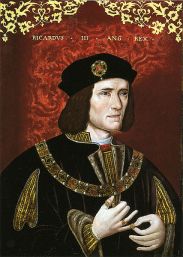 After the death of King Edward IV, his brother Richard briefly took responsibility for the safety of Edward's son King Edward V, and assumed the role of Lord Protector. Later, he is alleged to have placed Edward (aged 12) and his brother Richard (aged 9) in the Tower of London. They became known as the Princes in the Tower who mysteriously disappeared. Richard then seized the throne for himself. After the death of King Edward IV, his brother Richard briefly took responsibility for the safety of Edward's son King Edward V, and assumed the role of Lord Protector. Later, he is alleged to have placed Edward (aged 12) and his brother Richard (aged 9) in the Tower of London. They became known as the Princes in the Tower who mysteriously disappeared. Richard then seized the throne for himself.
Richard III was the last king from the House of York. His defeat by King Henry VIII's father Henry Tudor at the Battle of Bosworth marked the culmination of the Wars of the Roses, as well as the end of the Plantagenet dynasty. Richard's reign lasted from 22nd June 1483 to 22nd August 1485.
Richard had married Anne Neville, the younger daughter of the Earl of Warwick, on 12 July 1472. Anne's first husband had been Edward of Westminster, son of Henry VI. Richard and Anne had one son, Edward of Middleham, who died not long after being created Prince of Wales. Richard also had two acknowledged illegitimate children: John of Gloucester (also known as 'John of Pontefract'), who was executed by King Henry VII, and a daughter Katherine (d. before 1487). Both of his illegitimate children survived Richard, but seem to have died without issue. The mysterious Richard Plantagenet (Richard Eastwell) is also a possible illegitimate offspring of Richard III.
see also: <a class="external" href="http://www.youtube.com/watch?v=nPrRCmmG4ag" rel="nofollow" target="_blank" title='"Monarchy" by David Starkey about the War of the Roses'>"Monarchy" by David Starkey about the Wars of the Roses</a>
|
| | The houses of York and Lancaster were finally united with this union
and the Wars of the Roses which were a series of bloody dynastic civil wars
between supporters of the rival houses of Lancaster and York, for the throne of England.
They are generally accepted to have been fought in several spasmodic episodes
between 1455 and 1487 (although there was related fighting both before and after this period.)
The war ended with the victory of the Lancastrian Henry Tudor (Henry VII),
who was crowned October 30th, 1485 and founded the House of Tudor
which subsequently ruled England and Wales for the next 116 years.
|
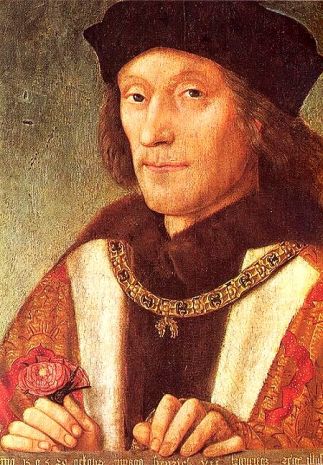
Henry VII
Father
born - 1457 crowned - 1485 died - 1509
This portrait by Michael Sittow is circa 1500 and shows Henry holding the red rose of the house of Lancaster.
Henry VII was the only child of Edmund Tudor, Earl of Richmond (son of Henry V's widow Catherine de Valois and Owen Tudor) and his 13-year old wife Lady Margaret Beaufort. His Father, Edmund died a few months before his birth so mother and son were cared for by Jasper Tudor, Henry's uncle.
The union of Henry and Elizabeth was both symbolic and necessary. Despite his victory at Bosworth, the exiled nobleman who took the name Henry VII needed the support of those sympathetic to the defeated Yorkist cause. He also needed the legitimacy of his wife's claim to the throne. He had spent years in exile and campaigned tirelessly to win support for his claim to the English throne. It had not been an easy task. In fact, it was only when Richard duke of York usurped the throne from his young nephew Edward (son and heir of Edward IV) that Henry Tudor became a viable candidate for king.
Henry Tudor's claim to the throne was never based on ancestry alone. He knew, none better, that such a claim would be flimsy at best. His royal blood came from women - his mother, Margaret Beaufort, was the granddaughter of John Beaufort (died 1410), the eldest of the bastard sons of John of Gaunt, duke of Lancaster. Gaunt's eldest legitimate son was the first Lancastrian king of England.
See also: <a class="external" href="http://www.youtube.com/watch?v=NrPdNaTzsO8" rel="nofollow" target="_blank" title="D. Starkey on Henry VII - money, war and rebellion">D. Starkey on Henry VII - money, war and rebellion</a>
| 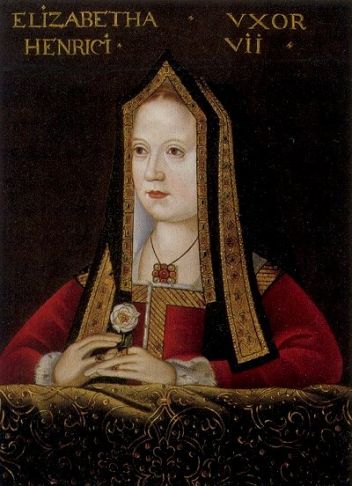
Elizabeth of York
Mother
born - 1466 died - 1503
This only known contemporary portrait is circa 1500 and shows Elizabeth holding the white rose of York as the sole surviving heir of the house of York (after her two brothers, the princes disappeared from the Tower of London).
Elizabeth of York was daughter of Edward IV and her marriage to Henry VII united the Houses of Lancaster and York (Henry claimed descent through his mother from John of Gaunt, Duke of Lancaster, son of Edward III).
She married Henry VII a few months after his victory at Bosworth Field, where he defeated her uncle, King Richard III. Elizabeth was a
popular queen and seemingly content with her sheltered domestic role. She had little choice in the matter; her mother-in-law, Margaret Beaufort was always the dominant female at court.
Elizabeth died on her 37th birthday, nine days after her 8th pregnancy ended in stillbirth. Her young son Henry Tudor (the future
King Henry VIII) was then at the
impressionable age of just 12.
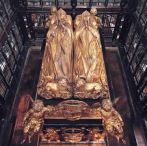
Henry VII & Elizabeth of York's
tomb at Westminster Abbey
| 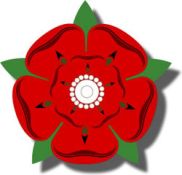 | 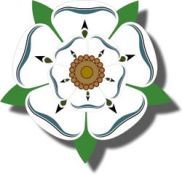 |
|

